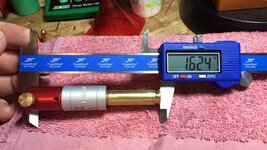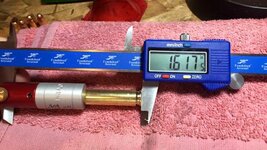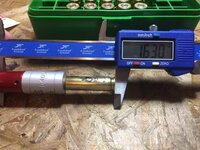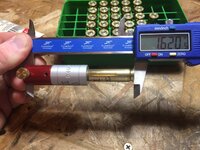Member 5605
- Messages
- 11,671
- Reactions
- 23,702
I'm working towards making specific brass for my rifle. For my rifle only.
The rifle:
Remington 700 in .308, 20" SPS Tactical
Gun has probably a little less than 80 rounds through it right now after break in and load development.
Brass is trimmed to 2.000" +/- .001, chamfered and deburred.
Here are a couple things I've come across and I want the local NWFA'ers opinions. You know, they are like feet. Sometimes they stink but sometimes people want to lick them.

I purchased some Federal .308 rounds and fired them in my rifle.
Using a Hornady headspace gauge I'm running with a .400" datum line setup.. I'm getting this:
My chamber: 1.6245" +/- .0005

I would resize my brass using a neck sizer which would keep the 1.6245" case length at the .400" line... BUT.. I was using my full length sizer to resize the brass down to: 1.6175" +/- .0005

Now this got me thinking.... and reading. Why am I using a neck sizer only, when I could take my full length brass and since I know exactly what my chamber is.. I could size some brass down to say 1.6220 +/- .0005??
So I tried it. I took a 1.6245" piece of brass, back my full length sizer die out and sized the brass. I figured it would grow a bit but the jump to 1.633" shocked me.

So I kept going down on the die in small increments....

Then I went .002" a little too far than I wanted....

So I'm essentially bumping the shoulder back .002" every time to ensure enough clearance and ease of feeding into the rifle.
The dilemma:
.620" was taking the overall spread and subtracting the .308", so spread from end to end was .928" outside of hole to outsid of hole.
The rifle:
Remington 700 in .308, 20" SPS Tactical
Gun has probably a little less than 80 rounds through it right now after break in and load development.
Brass is trimmed to 2.000" +/- .001, chamfered and deburred.
Here are a couple things I've come across and I want the local NWFA'ers opinions. You know, they are like feet. Sometimes they stink but sometimes people want to lick them.

I purchased some Federal .308 rounds and fired them in my rifle.
Using a Hornady headspace gauge I'm running with a .400" datum line setup.. I'm getting this:
My chamber: 1.6245" +/- .0005

I would resize my brass using a neck sizer which would keep the 1.6245" case length at the .400" line... BUT.. I was using my full length sizer to resize the brass down to: 1.6175" +/- .0005

Now this got me thinking.... and reading. Why am I using a neck sizer only, when I could take my full length brass and since I know exactly what my chamber is.. I could size some brass down to say 1.6220 +/- .0005??
So I tried it. I took a 1.6245" piece of brass, back my full length sizer die out and sized the brass. I figured it would grow a bit but the jump to 1.633" shocked me.

So I kept going down on the die in small increments....

Then I went .002" a little too far than I wanted....

So I'm essentially bumping the shoulder back .002" every time to ensure enough clearance and ease of feeding into the rifle.
The dilemma:
- Resize full length using only enough to set the shoulder back, not using my neck only sizer..
- Use neck sizing only if I'm not having feeding issues, when the headspace grows, then bump the shoulder back to .002" below chamber
- Keep neck sizing and only bump back when brass grows before chambering issues, keep full length die set to run 1.620" or slightly under that to 1.618" so any brass you get can be fire formed and then neck sized after that
.620" was taking the overall spread and subtracting the .308", so spread from end to end was .928" outside of hole to outsid of hole.
Last Edited:











